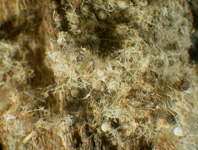Abstract
We describe and illustrate from the earliest Eocene amber of France the oldest representative of the rhagionid modern genus Symphoromyia, under the name of S. eocenica sp. nov. Its mouthpart structure shows that it was hematophagous as is the modern representatives of the genus, demonstrating a remarkable morphological stability for 53 Myr.
References
Angelini, P.-A., Dany Azar, A. & Nel, A. (2016) A new genus and species of snipe fly (Diptera: Rhagionidae) in Lebanese Cretaceous amber. Cretaceous Research, 58, 10–16.
http://dx.doi.org/10.1016/j.cretres.2015.09.018Brasero, N., Nel, A. & Michez, D. (2009) Insects from the Early Eocene amber of Oise (France): diversity and palaeontological significance. Denisia, 26, 41–52.
Cockerell, T.D.A. (1911) Fossil insects from Florissant, Colorado. Bulletin of the American Museum of Natural History, 30, 71–82.
Evenhuis, N.L. (1994) Catalogue of the fossil flies of the world (Insecta: Diptera). Backhuys Publishers, Leiden, 600 pp.
Evenhuis, N.L. (2014) Catalog of the fossil flies of the world (Insecta: Diptera) (Version 2.0). Avaliable from: http://hbs.bishopmuseum.org/fossilcat/ (accessed 03 October 2016)
Hennig, W. (1967) Die sogenannten “niederen Brachycera” im Baltischen Bernstein (Diptera: Xylophagidae, Xylomyidae, Rhagionidae, Tabanidae). Stuttgarter Beiträge zur Naturkunde, 174, 1–51.
Kerr, P.H. (2010) Phylogeny and classification of Rhagionidae, with implications for Tabanomorpha (Diptera: Brachycera). Zootaxa, 2592, 1–133.
McAlpine, J.F. (1981) Key to families, adult. In: McAlpine, J.F., Peterson, B.V., Shewell, G.E., Teskey, H.J., Vockeroth, J.R. & Wood, D.M. (coordinators), Agricultural Canada Monograph: Vol. 27. Manual of Nearctic Diptera, 1, research Branch, pp. 89–124.
Meunier, F. (1910) Monographie der Leptiden und der Phoriden des Bernsteins. Jahrbuch der Königlische Preussischen Geologische Landesanstalt, 28, 64–90.
Meunier, F. (1916) Sur quelques Diptères (Bombylidae, Leptidae, Dolichopodidae, Conopidae, Chironomidae) de l'ambre de la Baltique. Tijdschrift voor Entomologie, 59, 274–286.
Nel, A., de Ploëg, G., Dejax, J., Dutheil, D., de Franceschi, D., Gheerbrant, E., Godinot, M., Hervet, S., Menier, J.-J., Augé, M., Bignot, G., Cavagnetto, C., Duffaud, S., Gaudant, J., Hua, S., Jossang, A., de Lapparent de Broin, F., Pozzi, J.-P., Paicheler, J.-C., Bouchet, F. & Rage, J.-C. (1999) Un gisement sparnacien exceptionnel à plantes, arthropodes et vertébrés (Éocène basal, MP7): Le Quesnoy (Oise, France). Comptes-Rendus de l'Académie des Sciences, Paris, (IIa), 329, 65–72.
http://dx.doi.org/10.1016/s1251-8050(99)80229-8Paramonov, S.J. (1936) [On the entomofauna of ambers.] Trudy Instituta Zoologii Akademiia nauk SSSR Kiev, 18, 53–64. [in Russian]
Santos, C.M.D. & Amorim, D.S. (2007) Chrysopilus (Diptera: Rhagionidae) from Brazil: redescription of Chrysopilus fascipennis Bromley and description of eleven new species. Zootaxa, 1510, 1–33.
Stuckenberg, B.R. (1974) A new genus and two new species of Athericidae (Diptera) in Baltic amber. Annals of the Natal Museum, 22, 275–288.
Théobald, N. (1937) Les insectes fossiles des terrains oligocènes de France. Bulletin Mensuel (Mémoires) de la Société des Sciences de Nancy, 1, 1–473.
Turner, W.J. (1974) A revision of the genus Symphoromyia Frauenfeld (Diptera: Rhagionidae). I. Introduction, subgenera and species-groups, review of biology. Canadian Entomologist, 106, 851–868.
http://dx.doi.org/10.4039/Ent106851-8Zhang, J. (2013) Snipe flies (Diptera: Rhagionidae) from the Daohugou Formation (Jurassic), Inner Mongolia, and the systematic position of related records in China. Palaeontology, 56, 217–228.
http://dx.doi.org/10.1111/j.1475-4983.2012.01192.x

